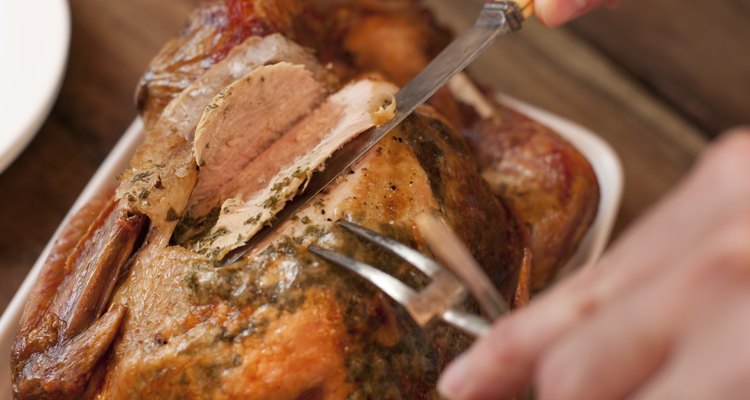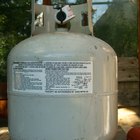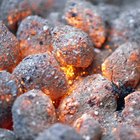
budgetstockphoto/iStock/Getty Images
Turkey is low in fat and high in nutrients, but it's difficult to cook without yielding meat that's dry and flavorless unless you add a calorie-packed sauce, says the "New York Times" food columnist and cookbook author Mark Bittman. (See Reference 1) While brining and basting help, directly injecting the turkey with low-calorie flavorings boosts the taste and tenderness of the meat with little effort and a minimum of added fat. (See Reference 2)
Pick a Low-Fat Flavoring Liquid
Liquids like low-sodium chicken or vegetable broth, wine, sherry, seasoned oils such as garlic-infused olive oil, flavored vinegars or 100 percent fruit juice add tenderness and flavor without the empty calories you'd receive from choices like melted butter. Load the liquid into a poultry injector, an inexpensive gadget you can find at most kitchen and home supply stores. Lift the skin and insert the injector into the meat, limiting the puncture sites to avoid losing moisture during cooking. (See Reference 2 and 4)
Spread it Around
Make the most of your high-flavor, low-fat liquid by using the same puncture site to infuse the meat in different areas of the turkey by changing the angle of injection several times. (See Reference 2 and 4) You'll end up with meat that's moist enough to avoid requiring the addition of fatty gravy. Insert the injector and release a small amount of liquid while slowly withdrawing the needle. Do not pull the injector completely out of the turkey. Instead, change the angle of the needle and repeat until you're out of fluid. (See Reference 2)
Inject Enough to Avoid Extra Fat
Plan on preparing at least 1 ounce of injectable marinade for every pound of turkey you are cooking. Less than this amount may not add enough moisture to avoid dryness. (See Reference 4) Recipetips.com recommends injecting each breast half and thigh with 1 to 2 ounces of fluid and reserving 3/4 to 1 ounces for both drumsticks. (See Reference 2) If you have leftover marinade, use it to inject the turkey back and the meaty portion of both wings. In every instance, aim to inject the meat under the skin. If that's not possible, puncture the skin in only one or two places and use an altered needle angle to spread flavor.
Let it Rest To Keep it Moist
Once the turkey has been injected with your choice of flavoring liquid, allow it to rest before cooking to ensure that the fluid has ample time to spread evenly throughout the meat. (See Reference 2) Place the turkey in a large roasting pan, cover it lightly with plastic wrap and refrigerate it overnight. Remove it from the refrigerator 1 hour before you plan to cook it. If you're going to roast the turkey and plan on using stuffing, don't fill the turkey cavity until just before you place it in the preheated oven. (See Reference 5)
Related Articles

How to Inject a Brisket
The Best Way to Cook a Small Turkey ...

How to Cook a Large Amount of Corned ...

How to Barbeque a Brisket on a Gas Grill

How to Smoke a Whole Pig Leg

How to Make a Turkey Baster

How to Cook a 15-Pound Rib Roast

How to Cook a Turkey Leg & Breast
Ideal Turkey Cooking Time by Weight

How to Make a Blackbuck Antelope Roast

How to Cook Turkey With Apple Juice

How to Cook Turkey Legs on the Grill

Does Simmering Ground Beef Make It More ...

How to Cook Boneless Turkey Breast

What are the Turkey Giblets & Neck Used ...

How to Smoke Buffalo Meat

The Best Way to Prepare Bison Sirloin

How to Marinate a Top Round Roast

How to BBQ a Half Pig

How to Use Coke to Tenderize Pork
References
- How to Cook Everything: Simple Recipes for Great Food; Mark Bittman
- Recipetips.com: Flavor Injecting Turkey
- Epicurious: Turkey Recipes and Tips
- The Ingredient Store.com: Injecting a Turkey
- Williams-Sonoma: How to Roast a Turkey
Resources
Writer Bio
Brynne Chandler raised three children alone while travelling, remodeling old homes, taking classes at the Unioversity of California Northridge and enjoying a successful career writing TV Animation. Her passions include cooking, tinkering, decorating and muscle cars. Brynne has been writing fun and informative non-fiction articles for almost a decade. She is hard at work on her first cookbook, which combines healthy eating with science-based natural remedies.
Photo Credits
budgetstockphoto/iStock/Getty Images